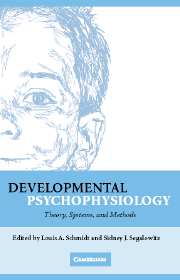Book contents
- Frontmatter
- Contents
- Foreword by Stephen W. Porges
- Preface
- Acknowledgments
- Contributors
- 1 Capturing the Dynamic Endophenotype: A Developmental Psychophysiological Manifesto
- SECTION ONE CENTRAL SYSTEM: THEORY, METHODS, AND MEASURES
- 2 Event-Related Brain Oscillations in Normal Development
- 3 Event-Related Potential (ERP) Measures in Auditory Development Research
- 4 Event-Related Potential (ERP) Measures in Visual Development Research
- 5 Electrophysiological Measures in Research on Social and Emotional Development
- 6 The Use of the Electroencephalogram in Research on Cognitive Development
- SECTION TWO AUTONOMIC AND PERIPHERAL SYSTEMS: THEORY, METHODS, AND MEASURES
- SECTION THREE NEUROENDOCRINE SYSTEM: THEORY, METHODS, AND MEASURES
- SECTION FOUR DATA ACQUISITION, REDUCTION, ANALYSIS, AND INTERPRETATION: CONSIDERATIONS AND CAVEATS
- Index
- References
5 - Electrophysiological Measures in Research on Social and Emotional Development
from SECTION ONE - CENTRAL SYSTEM: THEORY, METHODS, AND MEASURES
Published online by Cambridge University Press: 27 July 2009
- Frontmatter
- Contents
- Foreword by Stephen W. Porges
- Preface
- Acknowledgments
- Contributors
- 1 Capturing the Dynamic Endophenotype: A Developmental Psychophysiological Manifesto
- SECTION ONE CENTRAL SYSTEM: THEORY, METHODS, AND MEASURES
- 2 Event-Related Brain Oscillations in Normal Development
- 3 Event-Related Potential (ERP) Measures in Auditory Development Research
- 4 Event-Related Potential (ERP) Measures in Visual Development Research
- 5 Electrophysiological Measures in Research on Social and Emotional Development
- 6 The Use of the Electroencephalogram in Research on Cognitive Development
- SECTION TWO AUTONOMIC AND PERIPHERAL SYSTEMS: THEORY, METHODS, AND MEASURES
- SECTION THREE NEUROENDOCRINE SYSTEM: THEORY, METHODS, AND MEASURES
- SECTION FOUR DATA ACQUISITION, REDUCTION, ANALYSIS, AND INTERPRETATION: CONSIDERATIONS AND CAVEATS
- Index
- References
Summary
INTRODUCTION
The study of social and emotional development presents multiple complexities to the researcher. For instance, infants and young children cannot provide verbal report of their feeling states or moods, and researchers often rely on questionnaire measures given to parents or caregivers regarding the social or emotional behavior of the child. In addition, stimuli that elicit emotions in infants and young children are often age specific and the potency of these stimuli depends upon the context in which they are presented. The ability to present still pictures or video stimuli designed to elicit emotion (as is often done in adult studies) is compromised by the infant or young child's ability to attend to the stimulus, and more particularly by their ability to interpret or understand the nature of the stimuli. Finally, infants and young children display a good deal of motor behavior in response to events that elicit emotion. Such motor activity is particularly problematic for the recording of physiological responses, which are often subject to motor artifact. These issues are certainly not specific to the study of social and emotional development, and are also faced by researchers interested in cognitive as well as social and emotional development. Lack of verbal report, interpretation of stimulus characteristics, importance of context, variations in state and motor reactivity are all general problems faced in the study of infants and young children.
- Type
- Chapter
- Information
- Developmental PsychophysiologyTheory, Systems, and Methods, pp. 127 - 149Publisher: Cambridge University PressPrint publication year: 2007



